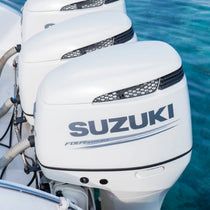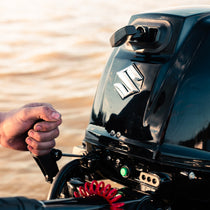

Suzuki Outboard 100-Hour Service Checklist
Periodic maintenance on your Suzuki outboard motor is essential for the most fun when you’re out on the water (and for the least amount of headaches, too!). For the longevity of your outboard, one of the most important maintenance intervals is the Suzuki outboard 100-hour service.
Suzuki outboard 100-Hour Service can be performed by most boaters with relatively simple mechanical know-how, OEM Suzuki outboard parts for replacements, and basic tools. You’ll save a lot of money in the long run.
Every six months or 100 hours of use, you need to perform Suzuki outboard 100-hour service to comply with your warranty, extend the lifespan of your outboard, and operate at optimal performance.
In this article, PartsVu provides a Suzuki outboard 100-hour service checklist and the actions you need to take for each step.
Suzuki Outboard 100-Hour Service Checklist
The following is a Suzuki outboard 100-hour service checklist to help you service your engine properly:
| Service Item | Action Needed |
| Grease Fittings | Lubricate |
| Engine Oil | Replace |
| Engine Oil Filter | Replace |
| Anodes | Inspect, replace as needed |
| Battery | Inspect |
| Power Trim and Tilt Fluid | Inspect |
| Connectors and Spray with Silicone Spray | Inspect & spray |
| Shift and Throttle Cable Linkages | Inspect |
| Retorque Bolts, Nuts, and Fasteners | Inspect |
| Engine Mounts and Steering Brackets | Inspect |
| Spark Plugs | Inspect, change as needed |
| Gearcase Oil | Replace |
| Inspect Fuel Lines | Inspect, replace as needed |
| Fuel-Water Separator | Replace |
| Fuel Stabilizer | Add before storing or when filling tank |
| Mounting Bolts | Inspect |
| Propeller and Skeg | Inspect |
| Cowling | Inspect |
| Telltale Hole for Water Flow | Inspect |
Lubricate Grease Fittings
One of the first steps for Suzuki outboard 100-hour service is to locate all grease fittings on your outboard. Using a grease gun, firmly attach the hose to any grease fittings and pump until grease begins to escape the joint. Wipe off any excess grease while leaving a small amount to ensure the fitting is protected against water infiltration.

Check Power Trim and Tilt Fluid
To ensure that your power trim and tilt work smoothly on your outboard, these directions will allow you to determine if your fluids are filled adequately.
- Raise the engine to a full-tilt position.
- Lower manual tilt lock lever
- Remove oil filler plug.
- If oil can be seen at the filler plug level, the unit is full.
- If the oil level is low, refill with recommended Suzuki power trim and tilt oil.
- Reinstall the oil filler plug.
Check Connectors and Spray with Silicone Spray
You should manually check all connectors to determine any loose connections or degrading parts (replace all degraded parts with only OEM Suzuki outboard parts). Once all connectors are determined to be fastened, lightly spray each connector with a silicone-based spray to prevent moisture buildup and corrosion.
Check Shift and Throttle Cable Linkages
Inspect your shift and throttle cable linkages for any fraying, excessive slack, and other signs of damage. If detected, replace with only OEM Suzuki outboard parts.
Retorque Bolts, Nuts, and Fasteners
Going around the engine, be sure to retorque all bolts, nuts, and fasteners with a torque wrench according to Suzuki’s recommended allowances (you can find this information in your engine’s owner’s manual).
Check Engine Mounts and Steering Brackets
Your engine mounts and steering brackets should be firmly secured to your boat. Look for extra play or leaks that indicate mounts and brackets need to be tightened for safe operation.
Check and/or Replace Spark Plugs
Look for signs of fouling and corrosion on your spark plugs. If detected, replace the spark plugs and use an anti-seize compound on the threads for easy removal in the future.
Check Your Gearcase and Powerhead Oil
You’ll want to check your gearcase and powerhead oil level for proper operation. To do so, remove the dipstick, clean with a rag, reinsert the dipstick, and take a reading.
During the Suzuki outboard 100-hour Service, perform a complete oil change using the Suzuki marine oil outlined in your owner’s manual. Additionally, you’ll need to change your gearcase oil.

Inspect Fuel Lines
Located at your fuel tank and water separator, ensure your fuel lines are tight and not leaking, and check for any signs of dry rot or cracks. You’ll need to replace if there are any signs of damage.
Replace Fuel-Water Separator
Replace the filter element of your fuel-water separator. Replacement is simple:
- Be sure to pinch off the fuel supply with a clamp to prevent any fuel from siphoning off during disassembly
- Place a catch pan below for any leaking fuel
- Using a strap wrench, turn the filter clockwise for removal.
- If the filter is equipped with a drain bowl beneath the filter, carefully remove this piece.
- Remove all old o-rings.
- Lubricate all replacement o-rings and replace.
- Install the drain bowl to the filter element (if applicable).
- By hand, twist the new filter element back on the threads.
- Once hand-tightened, use the strap wrench to continue tightening for no more than ¾ turn for a waterproof seal.
It’s important to note that you cannot reuse the filter element after dumping out any captured water and debris in the filter.
Add a Fuel Stabilizer
Because many modern fuels contain ethanol, adding a Suzuki Fuel Conditioner & Water Remover is important to prevent moisture from entering your engine via “phase separation.” This is especially important when filling up your fuel tank and when winterizing.
Check Mounting Bolts
Make sure that your mounting bolts are not loose, corroded, or damaged in any way. Tighten or replace as necessary.
Also, check that the head of the bolt is not sucking into the transom and cracking the gelcoat.
Check the Propeller and Skeg
Check your propeller and your skeg are in good shape. Look for any tangles around the spindle from seaweed, fishing line, and other debris. Consider a replacement if your prop has any bends or other visible damage.
Also, when removing the propeller, grease the prop shaft and reinstall with a new cotter pin.
Inspect the Cowling
Be sure to look at the air vents if your outboard’s cowling, as instructions like nests can block airflow to the engine. While this is a part of the Suzuki Outboard 100-Hour Service, you should perform this check each time you go in the water for optimal performance.

Inspect the Telltale Hole for Water Flow
Using earmuffs or when you’re by a water source, inspect the telltale hole for water flow. A lack of water flow may indicate an insect nest or debris, or it may require replacing the water pump impeller as necessary.
Grease the Lower Unit
After checking the water pump impeller, it’s important to lubricate the grease points in the splines and the bushing areas of the drive shaft of the lower unit. Also, be sure to grease your shift shaft.
As you can see, performing Suzuki outboard 100-hour service is a relatively simple process that most amateur boaters can perform. Of course, you should consult a qualified and certified Suzuki marine mechanic if you have any issues with your outboard. To help DIY boaters maintain their outboard, PartsVu offers plenty of Suzuki marine parts to get the job done. Better yet, purchase our Suzuki outboard maintenance kits and have everything you need on hand to enjoy your time out on the water!


















